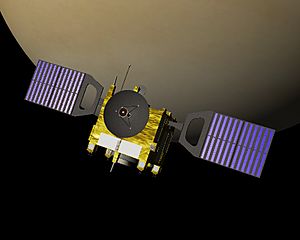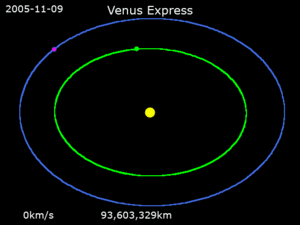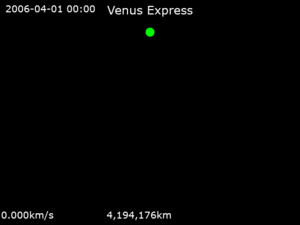Venus Express facts for kids

Venus Express in orbit
|
|
| Mission type | Venus orbiter |
|---|---|
| Operator | European Space Agency |
| Mission duration | Planned: 2 years Final: 9 years, 2 months, 9 days |
| Spacecraft properties | |
| Manufacturer | EADS Astrium |
| Launch mass | 1,270 kg (2,800 lb) |
| Dry mass | 700 kg (1,500 lb) |
| Payload mass | 93 kg (205 lb) |
| Dimensions | 1.5 × 1.8 × 1.4 m (4.9 × 5.9 × 4.6 ft) |
| Power | 1,100 watts |
| Start of mission | |
| Launch date | 9 November 2005, 03:33:34 UTC |
| Rocket | Soyuz-FG/Fregat |
| Launch site | Baikonur 31/6 |
| Contractor | Starsem |
| End of mission | |
| Disposal | Deorbited |
| Last contact | 18 January 2015, 15:01:55 UTC |
| Decay date | January / February 2015 |
| Orbital parameters | |
| Reference system | Cytherocentric |
| Pericytherion | 460 km (290 mi) |
| Apocytherion | 63,000 km (39,000 mi) |
| Inclination | 90 degrees |
| Period | 24 hours |
| Venus orbiter | |
| Orbital insertion | 11 April 2006 |
 ESA Solar System insignia for the Venus Express mission |
|
The Venus Express (VEX) was an important space mission by the European Space Agency (ESA). It was the first time ESA sent a spacecraft to explore Venus. Launched in November 2005, it reached Venus in April 2006. The spacecraft then started sending back scientific information from its orbit around the planet.
Venus Express had seven special tools, called instruments, on board. Its main goal was to study the atmosphere of Venus for a long time. No other mission had observed Venus's atmosphere for such a long period before. This long-term study was very important for understanding how the atmosphere of Venus works. The ESA finished the mission in December 2014.
Contents
How the Venus Express Mission Began
The idea for Venus Express came up in 2001. Scientists wanted to reuse the design from another mission called Mars Express. However, Venus is much closer to the Sun than Mars. This meant the spacecraft would get much hotter. So, engineers had to make changes to how the spacecraft handled heat, communicated, and got its power.
For example, because Venus is closer to the Sun, the solar panels on Venus Express got more sunlight. This meant they could make more electricity. The mission also used some extra instruments that were made for the Rosetta spacecraft.
Launching and Reaching Venus
The best time to launch Venus Express was between October 26 and November 23, 2005. The launch was first planned for October 26. But there were some small problems with the insulation on the rocket's upper part. This caused a two-week delay.
Finally, Venus Express was launched on November 9, 2005. It took off from the Baikonur Cosmodrome in Kazakhstan using a Soyuz-FG/Fregat rocket. After launching, it first went into an orbit around Earth. About 1 hour and 36 minutes later, it moved into its path towards Venus.
The spacecraft traveled for 153 days. It arrived at Venus on April 11, 2006. To get into orbit around Venus, it fired its main engine. This slowed it down so that Venus's gravity could pull it into orbit. The first orbit lasted nine days.
After that, Venus Express performed seven more maneuvers. These helped it reach its final orbit around Venus. This final orbit was a polar orbit, meaning it flew over the North and South poles of Venus. It took 24 hours for the spacecraft to complete one trip around the planet.
What Venus Express Studied
Venus Express carefully studied the atmosphere and clouds of Venus. It also looked at the space environment around Venus, which is full of charged particles called plasma. The mission even mapped the surface temperatures of Venus from orbit.
The mission was originally planned to last for 500 Earth days. But it was so successful that it was extended five times! The final extension meant the mission continued until 2015.
On November 28, 2014, mission control lost contact with Venus Express. They got some contact back on December 3, but they couldn't control the spacecraft anymore. This was probably because it had run out of fuel. On December 16, 2014, ESA announced that the mission had officially ended. The last signal from the spacecraft was received on January 18, 2015. Scientists expected it to fall into Venus's atmosphere and burn up in early 2015.
Tools for Discovery: The Instruments
Venus Express carried several special tools, or instruments, to help it study Venus. Each instrument had a unique job.
ASPERA-4: Studying Solar Wind
ASPERA-4 stands for "Analyzer of Space Plasmas and Energetic Atoms." This instrument studied how the solar wind (a stream of particles from the Sun) interacts with Venus's atmosphere. It helped scientists understand how plasma affects the atmosphere and looked at charged particles and neutral gases around Venus. ASPERA-4 was an improved version of a similar instrument used on Mars Express.
MAG: Measuring Magnetic Fields
The MAG instrument was a magnetometer. It was designed to measure the strength and direction of Venus's magnetic field. This field is affected by the solar wind and Venus itself. MAG helped map the magnetic regions around Venus in detail. It also helped ASPERA-4 study the solar wind's interaction with Venus. MAG even looked for lightning on Venus!
To get accurate readings, MAG had two sensors. One was on the spacecraft body, and the other was on a 1-meter-long boom that unfolded away from the craft. This allowed scientists to separate the small natural magnetic fields from the spacecraft's own magnetic interference.
VMC: Taking Pictures of Venus
The VMC, or "Venus Monitoring Camera," was a wide-angle camera. It was designed to take global images of Venus. It could see in visible light, ultraviolet (UV), and near-infrared light. VMC helped map the brightness of the surface to look for volcanic activity. It also monitored airglow (light emitted by the atmosphere) and studied strange UV-absorbing areas in the clouds.
The VMC used a special sensor called a CCD with 1024 x 1024 pixels. It also had a special chip to process images before sending them to Earth.
| VMC Channel | Central Wavelength | Spectral Range |
|---|---|---|
| VIS | 513 nm | 503 – 523 nm |
| NIR1 | 935 nm | 900 – 970 nm |
| NIR2 | 1.01 μm | 990 – 1030 nm |
| UV | 365 nm | 345 – 385 nm |
PFS: Sounding the Atmosphere
The "Planetary Fourier Spectrometer" (PFS) was designed to study Venus's atmosphere using infrared light. It was supposed to measure temperatures in the lower atmosphere (from the clouds up to 100 kilometers high). It also aimed to find new gases, analyze aerosols (tiny particles), and study how the surface and atmosphere interact. Unfortunately, the PFS instrument had a problem during its setup and did not send back any useful data.
SPICAV: Analyzing Atmospheric Light
SPICAV stands for "Spectroscopy for Investigation of Characteristics of the Atmosphere of Venus." This instrument was an imaging spectrometer. It analyzed light in the infrared and ultraviolet parts of the spectrum. SPICAV was based on an instrument from Mars Express. It had an extra part called SOIR (Solar Occultation at Infrared). SOIR observed the Sun through Venus's atmosphere in infrared light.
VIRTIS: Seeing Heat and Light
The "Visible and Infrared Thermal Imaging Spectrometer" (VIRTIS) was another imaging spectrometer. It observed Venus in near-ultraviolet, visible, and infrared light. VIRTIS helped scientists analyze all the layers of the atmosphere. It also studied surface temperature and how the surface and atmosphere affect each other.
VeRa: Using Radio Waves
VeRa, or "Venus Radio Science," was a radio experiment. It sent radio waves from the spacecraft through Venus's atmosphere or bounced them off the surface. These radio waves were then picked up by a ground station on Earth. By studying these waves, scientists could learn about Venus's ionosphere, atmosphere, and surface. This instrument was similar to one used on the Rosetta mission.
Key Discoveries and Science
Venus Express helped scientists learn a lot about Venus.
Understanding Venus's Climate
Venus and Earth started out very similar in size and what they were made of. But their histories changed in very different ways. Scientists hoped that data from Venus Express would help them understand how Venus's atmosphere is built. They also wanted to know what caused the planet to have such a strong greenhouse effect. Learning about Venus's climate could even help us understand climate change on Earth.
In 2006, the mission's research showed clear differences between Venus and Earth. It also began to observe regular climate changes on Venus.
Looking for Life on Earth from Venus
Venus Express also did something unique: it observed Earth from its orbit around Venus. In these images, Earth looked like a tiny dot, less than one pixel in size. This was like how we might observe Earth-sized planets around other stars. These observations helped scientists develop ways to study if planets in other planetary systems could support life.
Mission Milestones: A Timeline
Here are some important dates and events from the Venus Express mission:
- August 3, 2005: Venus Express finished its final tests in France.
- August 7, 2005: The spacecraft arrived at the Baikonur Cosmodrome.
- November 9, 2005: Venus Express launched from Baikonur at 03:33:34 UTC.
- November 11, 2005: The first path correction was successfully done.
- February 17, 2006: The main engine was tested successfully for the arrival maneuver.
- April 11, 2006: Venus Express successfully entered orbit around Venus.
- April 13, 2006: The first images of Venus from Venus Express were released.
- May 7, 2006: Venus Express reached its final target orbit.
- December 14, 2006: The first temperature map of Venus's southern hemisphere was created.
- February 27, 2007: ESA agreed to extend the mission until May 2009.
- September 19, 2007: The original mission ended, and the first extension began.
- November 27, 2007: New findings were published, including evidence for past oceans and lightning on Venus. A huge double atmospheric vortex was found at Venus's south pole.
- May 20, 2008: The detection of hydroxyl (OH) in Venus's atmosphere was reported.
- February 4, 2009: ESA extended the mission again, until December 31, 2009.
- October 7, 2009: ESA extended the mission until December 31, 2012.
- November 23, 2010: ESA extended the mission to 2014.
- August 25, 2011: A layer of ozone was reported in Venus's upper atmosphere.
- October 1, 2012: A cold layer where dry ice might form was reported in Venus's atmosphere.
- June 18 – July 11, 2014: The spacecraft performed a successful aerobraking experiment.
- November 28, 2014: Mission control lost contact with Venus Express.
- December 3, 2014: Intermittent contact was made, but the spacecraft was likely out of fuel.
- December 16, 2014: ESA declared the Venus Express mission over.
- January 18, 2015: The last signal from the spacecraft was detected.
See also
- Uncrewed space mission
- List of planetary probes
- List of missions to Venus
- Space exploration
- Space probe



